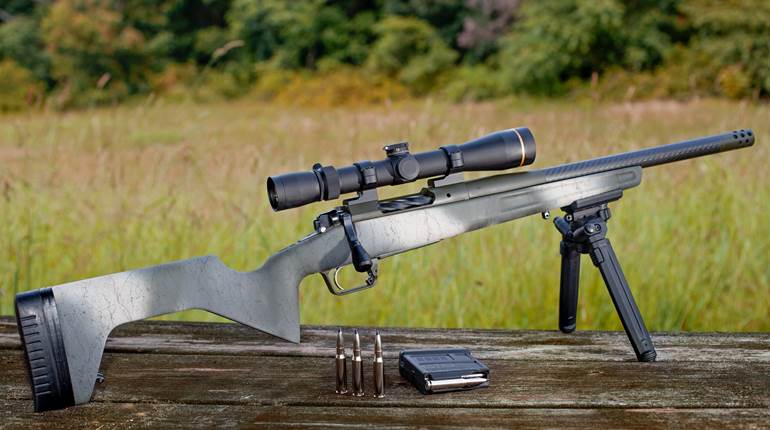
Not all shooters are on board with the synthetic-stock movement that has taken over today’s rifle market, and Savage is well aware of that. In response, the company still offers a variety of wood-stocked options. And because those questing for the nostalgia of that first hunt are not always keen on the idea of sacrificing modern features, the Savage Arms 110 Classic delivers both. Our test sample was chambered for .243 Win., however, seven other cartridge options are also available.
Built on the company’s revered Model 110 action, the Classic expands the line with a fully adjustable oil-rubbed walnut stock. Making use of modern ergonomics, the stock is not only adjustable for length of pull, but comb height as well; just the press of a button allows the spring-loaded buttpad and comb to be adjusted on the fly. The buttstock is capped off with a rubber recoil pad for comfort while firing, as well as slip control when shouldering the gun.

Rather than utilizing Savage’s AccuStock system, the Classic’s stock is precisely fit to the action the “old fashioned way,” and is secured with metallic pillars, ensuring a firm connection between these two critical parts. In addition to the pillar bedding, the barreled action aligns with a groove in the stock that restricts forward or rearward movement, resulting in a solid shooting platform.
Like other Model 110 rifles, the Classic is built with many of the same features that made Savage famous, including a floating bolt head that reduces bullet runout by allowing the case to align with the bore before each shot. The new bolt gun also incorporates the user-adjustable AccuTrigger. A competitive edge for Savage, the trigger is drop-safe, and can be dialed down to some very light pull weights. Our test rifle came to us with a trigger weight of 4 lbs., 3 ozs., which we were able to safely reduce all the way down to 2 lbs., 8 ozs. This was done with just the turn of a screw once the stock was removed.

The three-position safety ensures reliable fire control with additional options for loading and unloading. The bolt can still be opened or closed while the safety is in its center position, although the rearward position locks both the bolt and the trigger. The 22" button-rifled barrel is attached to the carbon steel receiver by a traditional Savage barrel nut. Our test rifle’s barrel was cut with a right-hand, 1:9.25" twist rate, which is optimal for nearly all factory-loaded .243 ammunition. Feeding the action is a four-round detachable box magazine, yielding a total capacity of five. At the business end is 9/16x28 TPI threading for the installation of accessories. We utilized a Kahntrol Solutions HexMod muzzle brake for our function testing, which all but eliminated the felt recoil of the already light .243 rounds.
The receiver of Savage’s new offering comes drilled and tapped for a scope mount, to which we installed a one-piece Weaver base and topped it with a 4-16X 50 mm Riton Mod 5. We chose a 4-16X optic because it delivers excellent field of view for close-range brush hunting, yet allows for significant magnification for long-range varminting. It was a natural choice for this gun, as the .243 Win. cartridge is equally at home in either scenario.
For accuracy testing we used Hornady’s 80-gr. Outfitter load, Black Hills’ Gold 85-gr. Barnes TSX ammunition and 75-gr. Federal American Eagle Varmint & Predator JHPs. Surprisingly, top dog on the range was the economical American Eagle load, with a best group of 0.89" and a five-group average of 1.28". Recoil was manageable with or without the Kahntrol brake, as we were able to spot nearly all of our rounds impacting the 100-yd. target through the scope. Throughout our testing feeding was flawless, and bolt operation was quick and smooth.

Overall, we were impressed with the rifle, although we would like to see a more straightforward magazine system. The detachable magazine on the 110 series of rifles requires the rear to be completely flush before the front will snap into place. Interestingly enough, even when we didn’t have the magazine seated properly it still fed rounds reliably, although its removal, when empty, required extra effort.
Another potential upgrade would be the ability to adjust the AccuTrigger without having to remove the stock; removing and re-installing the stock repeatedly as you try to find your desired pull weight tends to get a little arduous. Other than that, the Savage 110 Classic provides shooters who still insist on using a walnut-stocked rifle with an accurate, attractive platform that can be adjusted to match the dimensions of its user.







































